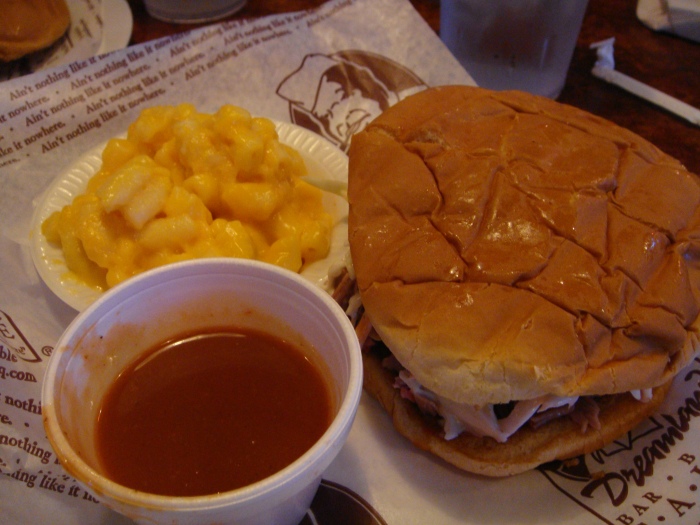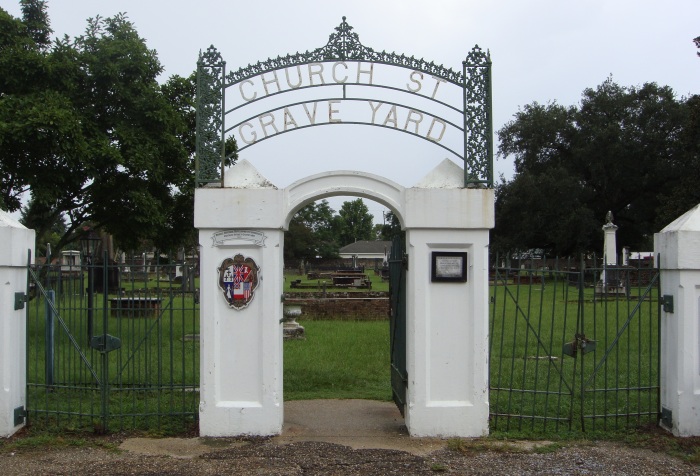In July, husband John and I traveled to Mobile, Ala., for a wedding. The wedding was actually an hour away in Gulf Shores, but we decided to stay in Mobile because we’d never been there and thought it might be a neat, historic city to explore.
Before leaving Lynchburg, I did some online research about things to see and do in Mobile. Because we’d be driving the 800-plus miles, deep into what’s been called “The Heart of Dixie,” I also scouted interesting things to see along the route we’d be taking through Chattanooga, Tenn., and Montgomery, Ala.
Eight-hundred miles is a long way to drive and we’d only actually be in Mobile for two days, but John and I love a good road trip. A few tanks of gas, a couple bags of caramel Bugles and a season of “This American Life” on the iPod and we’re good to go.
For instance, we once drove 1,800 within the state of Arizona in one week. In New Mexico, noting that the grave of Billy the Kid was only 154 miles away in Fort Sumner, we said, “Yeah, let’s go!” Closer to home, we once drove five hours to the Eastern Shore of Virginia just to eat shrimp at an Exxon station and drive back home. It’s safe to say we love road trips.
On this trip, we decided to take the slightly longer route through Chattanooga and Montgomery instead of heading through Atlanta, because my traveling-salesman dad had said traffic in Georgia’s capital could be terrible. That said, while traffic was light in Chattanooga — where (historical side note) my great-great-grandpa August Siegmund fought two battles for the Union with the mostly German Ninth Ohio Infantry — it took an eternity to get to Montgomery, our stop for the night.

After checking into a hotel, we drove into Alabama’s capital city. The first thing we had to find was food. The hotel clerk recommended Dreamland, a barbecue restaurant in a section of downtown Montgomery called “The Alley.”
The first Dreamland Cafe opened in 1958 in Tuscaloosa, Ala. There’s a great story on the restaurant’s website about how the founder, a brick mason named John “Big Daddy” Bishop, prayed to God for guidance about how to best support his family.
“He had narrowed it down to opening either a mortuary or a restaurant and he got down on his knees for guidance,” the story goes. “Legend has it that God told him in a dream that night to build a cafe on the land next to his home and Big Daddy made that dream a reality.”
Today, there are nine Dreamland locations in Alabama, Georgia and Florida.

John and I both had the pork barbecue sandwich, he with his usual side of fried okra and me with my usual choice of macaroni and cheese. John later said it was the best barbecue he’d had in a while, possibly ever. The only disappointing thing for me was that I was too full afterward to order the banana pudding, which is supposed to be amazing. Maybe next time!
Dreamland sits catty-corner from the city’s minor-league baseball field. The team is nicknamed “The Biscuits,” which I thought was adorable. The mascot is a biscuit, of course. It’s like a clam but instead of a pearl, there’s a pat of butter in its mouth.

The Biscuits have a live mascot, too, which we met outside the stadium. It’s a pot-bellied pig named Mrs. Gravy. She was very cute and liked to be petted.
After dinner, John and I walked to the Alabama capitol building. It was grand and everything you’d imagine in a Southern capitol. Outside, there was a half-ring of flags of the 50 states. At the base of each, there was a native stone engraved with the name of the state.

As we approached Virginia’s flag, John and I suspected the stone would be greenstone, which was mined in Lynchburg. Sure enough, it was.
On the way to the capitol building, we passed the Dexter Avenue King Memorial Baptist Church where, according to the historical marker outside, Martin Luther King Jr. was pastor from 1954 to 1960. There also were markers near the capitol commemorating the 54-mile “freedom march” from Selma, Ala., to Montgomery in 1965.
The next day, John and I drove on to Mobile, said to be the oldest city in Alabama and the actual birthplace of Mardi Gras. Like New Orleans to the west, Mobile is a melting pot with French, Spanish, British, Creole, African and other cultural influences. As one might expect, there are lots of live oaks and southern mansions.
When we arrived in Mobile, our first thought was of food. Before the trip, I’d scouted the dining options and happened upon Callaghan’s Irish Social Club, which is located in the historic Oakleigh Neighborhood.
Callaghan’s specialty is the LA — as in “Lower Alabama” — Burger. It’s made from a combination of beef and something called Conecuh sausage, and you have to get there before noon or they’ll run out of it.
For those of you who don’t know — I didn’t — Conecuh is the name of the Alabama county where the sausage is made.
Unfortunately, it was Friday and the LA Burger is only available on Wednesdays and Thursdays. I ordered a regular cheeseburger, which was great, and John ordered his usual far-southern fare, the shrimp po-boy.
We didn’t have a lot of time in Mobile, but we did a few things. Over the next two days, we visited the Old Plateau Cemetery, where many survivors of the slave ship Clotilda are buried. I wrote about that last week, and you can read about it here.

We also went to the Church Street Grave Yard, where I’d hoped to find the grave of Confederate Civil War General Braxton Bragg.
Church Street Grave Yard is located next door to Mobile’s downtown public library. John and I ducked inside the library to escape an afternoon rainstorm and were greeted with marble floors, iron railings and other extravagances. It was an impressive public library and is worth a look, even if it’s not raining.
The cemetery, on the other hand, was suffering from an serious lack of upkeep. The grass was a foot tall in places. There were beer cans strewn about and some monuments and decorative fences were toppled. There was a sketchy-looking man that kept going in and out of the cemetery while we were there.

Despite that, it was a neat place to visit and we walked around for a while.
For all our looking around the grave yard, however, we did not see the grave of Braxton Bragg. That, as I would discover much later, was because he wasn’t there. He’s buried at Magnolia Cemetery, which is also in Mobile. Oh well, maybe next time!
The third historic site we visited in town was the History Museum of Mobile. It’s housed in a circa-1855 building that also has served as a market and later as Mobile’s city hall. As you’d expect, it was full of things — apparently 90,000 items — related to the history of Mobile.


The museum was definitely worth visiting and, at $10, was not a big splurge.
In Mobile, we stayed at the Malaga Inn, which was once two homes. It was built for two sisters and their husbands in 1862. It was comfortable, affordable ($125/night), and within walking distance to restaurants and historic sites. I’d definitely stay there again.
After attending the wedding Saturday evening, John and I got back in the car Sunday morning and headed toward home. We’d planned to make it to at least Knoxville that day, but then switched gears and headed for Cookeville, Tenn. John went to college there at Tennessee Tech. It’s also home to Ralph’s Donuts.
Ralph’s had been around for decades and was a favorite hangout for John and his college buddies. I’ve been there a dozen times over the years and I’m particularly fond of the maple-frosted donut. So, when John suggested we go two hours out of our way for a donut, I was game.
Unfortunately, when we arrived in Cookeville, Ralph’s was closed, and would also be closed the following Monday morning. Since we’d last been to Ralph’s, the previous December, the hours had changed. Now, they’re closed Sundays and Mondays, much to our disappointment.
Oh well, as had become a refrain on this trip, “Maybe next time!”
You guys made the most of every minute of that trip. I can’t believe you missed out on Ralph’s. That just stinks!
LikeLike
I know! Ralph’s is great. Best donuts I’ve had anywhere. Definitely worth a 10-minute detour off I-40 if you’re traveling between Knoxville and Nashville!
LikeLike
Interesting trip, I enjoyed your story and there is more to see when you have time. Conecuh sausage is sold in many Publix stores. It’s pretty good, too, but not as good as my great uncle’s who farmed in Botetourt county, Va. John Sessions, the owner of Conecuh, has a beach home in my neighborhood.
By the way thanks for the story of my great uncles and aunt, the four Stephens babies.
LikeLike
Thanks, Bob! And you’re welcome! It was a very interesting and sad story, about the Stephens children. When I see so many baby graves, right together, I’m always curious about what happened. I would love to know more about the family, like what the father did for a living. In the census records, I was never quite sure I had the right family. I think the James Stephens I did find worked as a carpenter or contractor. Could that be him? Thanks for the tip on where to find Conecuh sausage. We don’t have any Publix stores in Lynchburg, but I do see them farther south and will have to stop by and get some!
LikeLike
Sounds like a great road trip. We’ll definitely visit some of these stop on a future drive.
LikeLike
Thanks for reading!
LikeLike